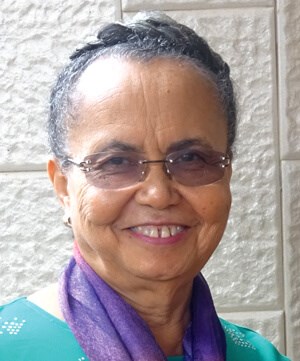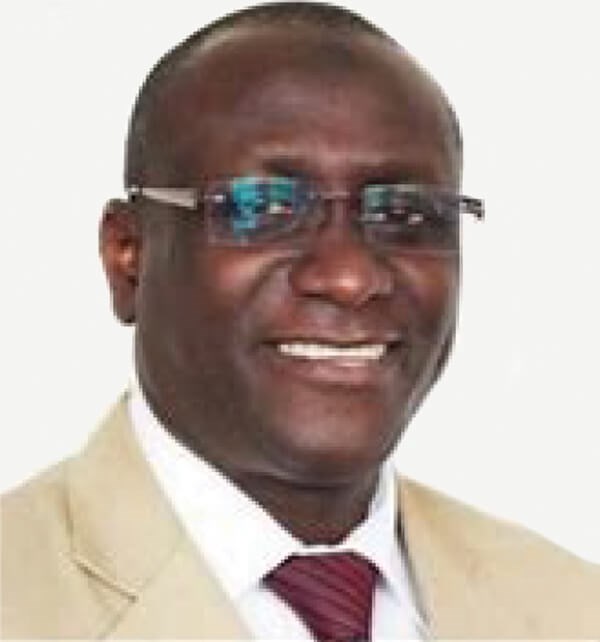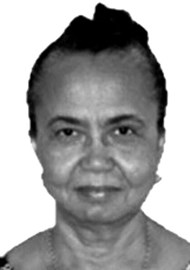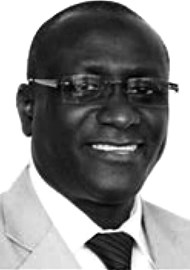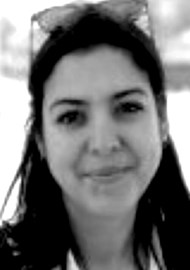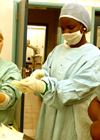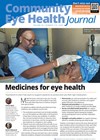This article brings together the three national eye health surveys that have been undertaken in The Gambia between 1986 and 2019 and the impact that the results have had nationally and internationally. In it we describe the long-term capacity-strengthening for tertiary eye services in The Gambia through the VISION 2020 LINK with Swansea.
Eye health programming in sub-Saharan Africa in the 1980s
In the 1980s, population-based data on the prevalence of vision impairment and blindness in sub-Saharan Africa were incredibly scarce. One survey had been undertaken in southern Malawi in 1983, and another in the Luapula Valley of Zambia in 1985 [1,2].
The World Health Organization (WHO) was promoting and rolling out the philosophy of primary health care (PHC) at that time. A major blinding disease, onchocerciasis, was going to be eradicated with a new drug: ivermectin. In response, primary eye care strategies were being developed and implemented in districts in sub-Saharan Africa, advocated for by the International Agency for the Prevention of Blindness (IAPB) [3]. And community eye health as a philosophy and strategy was being taught as a course at the International Centre for Eye Health (ICEH), London [4].
The need for a national survey – Hannah Faal
It was against this background that I, Hannah Faal, as the only ophthalmologist working in The Gambia, underwent a paradigm shift in thinking, from focusing on the clinical care of individual patients, to care for a national population. At the time, The Gambia had an excellent primary health care system. Its key characteristics were a small size and population (800,000 people), a supportive, committed government, and a foundation of primary health care within the government health system. Into this mix, as a Nigerian ophthalmologist with a public health orientation and a commitment to leadership, I developed and integrated a national comprehensive eye care plan.
Training in the science behind eye care programming was provided at ICEH when I attended the course in 1985. The course emphasised the need for evidence, ideally through a national population-based survey, which would ask the relevant research questions on the prevalence, causes and distribution of blindness and visual impairment.
The first National Eye Health Survey in The Gambia, 1986
The first National Eye Health Survey in The Gambia was conducted the following year, after my ICEH training [5]. The survey, which examined nearly 9000 people across the country, also tested simplified survey methodologies; a simplified trachoma grading system, the use of allied eye health professionals in the team, and simple design, analysis and presentation of results.
This survey brought together global actors; ICEH actively participated in the design, conduct, analysis and publication of the survey, and used the results for teaching on its courses. The WHO (in both The Gambia and Geneva) participated in the sponsorship and the conduct of the survey, its dissemination and adoption.
This first survey provided the evidence for the design of a 10-year National Eye Care Plan in two-year phases, geographically phased, with two main objectives:
- The reduction of blindness prevalence by 50%, and
- A prevalence of not more than 1% in any community.
The government of The Gambia was central to the survey and its use in the implementation of the plan. The revised and tailored plan, stemming from the survey results, attracted the interest and commitment of non-governmental organisations including Sightsavers, and the science attracted the Medical Research Council (MRC) in The Gambia.
Bringing eye services closer to the community
The model that the National Eye Care Programme (NECP) adopted was an upside-down pyramid, with the community-based primary health care system at the top (one primary eye health worker per 400 or so people), a bridging cadre of community ophthalmic / general nurses per 10,000-30,000, secondary senior ophthalmic medical assistants / cataract surgeons at the regional level (per 150,000-200,000) and a central tertiary ophthalmologist and staff team supporting the national programme. Each level had supportive supervision, training and geographical coverage responsibility for the level above.
Specific strategies addressing the main causes of blindness and visual impairment, i.e. cataract, non-trachomatous corneal scarring and trachoma, were designed and implemented. A great effort was made to absorb and use traditional health systems, based on a philosophy of making the best and most of existing systems and resources. Routine programme data collection, monitoring and evaluation ensured the evidence-based objective. Research was very much part of the national programme, in collaboration with ICEH and the MRC.
Follow-up survey after 10 years of programme implementation
Ten years later, in 1996, a second national population-based survey was designed and conducted to allow full comparison with the first survey, along with an evaluation of the programme [6]. This provided the evidence that with a comprehensive integrated national programme, blindness had reduced by 40%. This was a significant achievement, especially in the context of The Gambia being a low-income sub-Saharan country. Throughout the 10-year period, the programme functioned as a laboratory, testing strategies and producing results that could be used in training and programmes nationally and internationally, as advocated by key partners. This second survey also allowed the testing of the Henson visual fields machine in challenging field conditions.
Impact of the surveys on design and implementation of global programmes
Evidence from our programme provided the foundation and the impetus for the WHO Global Elimination of Trachoma campaign [7] that started in 1996 and the global WHO-IAPB initiative ‘VISION 2020: The Right to Sight’ [8], three years later.
Impact of the surveys on elimination of trachoma
Shortly after the second national eye health survey, the NECP conducted a national trachoma mapping exercise, using ‘trachoma rapid assessment’ (TRA) exercises, which were able to exploit the newly-developed Geographic Information System (GIS). This system pinpointed individual trachoma cases in their respective villages (to the nearest metre) and their eye disease status – active cases (those that are infectious with trachoma) or those with inturned eye lashes (the complication that indicates the highest risk for blindness) or those that have been treated (non-infectious / inactive cases).
The GIS was the precursor of the modern version of Google Maps on our smartphones. Three decades ago, we were able to ‘track and view’ every identified trachoma case in every settlement throughout The Gambia and this robust database provided the evidence that subsequently led to the elimination of trachoma in the Gambia [9,10].
Surveys: a practical guide
1. What do surveys need to be able to successfully support planning?
-
A survey answers the question: Where are we now?
-
For a survey to be useful, it must be prefaced by a plan and commitment to implement change in pursuit of: Where do we want to be?
-
A successful survey requires the many actors involved, each with its own objectives and benefits, to be fully on board
-
The eye health workers and scientists designing and carrying out the survey, who may see it as a benefit in enhancing their work and contributing towards their career development
-
The institutions for training and teaching resources
-
The sponsors for knowledge and information for their programmes
-
The health stakeholders for evidence-based decision making
-
The government, for developing and implementing effective programmes to meet the identified needs of the people.
2. What does the conduct of a successful survey entail?
-
The understanding of the importance of each phase: preparation, field work, wrapping up
-
The importance of attention to detail, collection and transmission of data
-
The knowledge of the area and the people being surveyed
-
The formation of relationships with the population, particularly if the survey is followed by the implementation of the plan and its interventions
-
A paradigm shift in thinking, from individual care to population care
-
The building of teams and leadership
-
Skills in the management of resources, time and finances
-
The skills of adaptation and quick response to difficulties and changes
-
The stages of data management, analysis, dissemination, publications and use
-
The importance of going back to the population with the results presented in a way through which they can ‘own’ the outcome.
Clearly a survey has many benefits besides the immediate results and publications. In particular, governments act mainly on policy directives and the best policies are strongly rooted in real-life evidence. National surveys provide that evidence.
Findings from the second survey and their implementation in The Gambia – Abba Hydara
The 1996 survey revealed a large number of Gambians with visual impairment due to uncorrected aphakia. This had resulted from increased cataract surgical rate and cover but the resultant postoperative visual rehabilitation (provision of aphakic spectacles) was weak and restricted to only the four eye centres that regularly conducted cataract surgery. Subsequently, the Ministry of Health built the requisite human resource and capacity to modernise cataract surgery by upgrading to the provision of advanced microsurgical services with intraocular lens implantation nationwide.
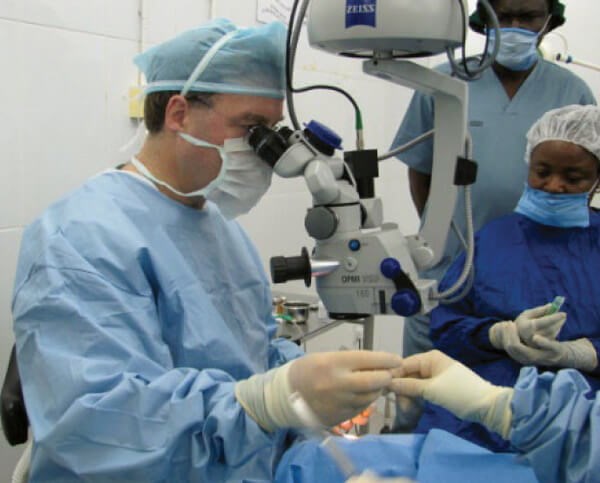
Mike Austin teaching trabeculectomy.
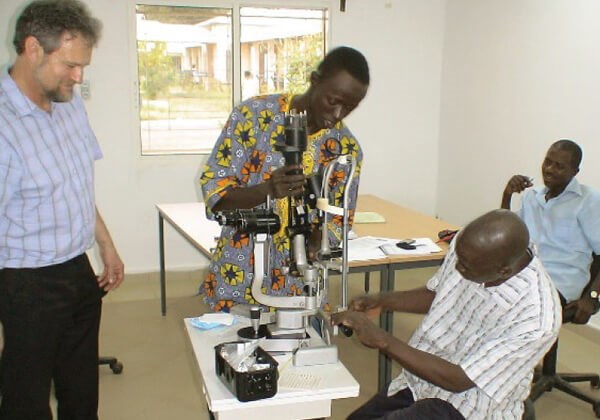
Slit-lamp maintenance overseen by Paul Lawrance.
Uncorrected refractive error (URE) remains one of the leading causes of visual impairment worldwide and The Gambia’s eye services, now known as the National Eye Health Programme (NEHP), has adapted to deal with this by collaborating with international partners and opening vision centres that specifically address the challenges of URE by the provision of spectacles to people who need them but cannot afford them in the open market.
Development of LINK partnership between The Gambia and Swansea
As the ophthalmology services developed, so did the need for strengthening key areas such as paediatric ophthalmology and glaucoma at tertiary level at the main hospital, Sheikh Zayed Regional Eye Care Centre (SZRECC) in Banjul. In 2007 the VISION 2020 LINKS Programme was asked to find a UK partner, and in 2008 the LINK with the Singleton Hospital Ophthalmology Department in Swansea was established.
Strong engagement on both sides enabled annual exchange visits over many years, with hands-on training by the Swansea team, including ophthalmologists, nurses, equipment engineers, optometrists and orthoptists, at SZRECC, with return visits for SZRECC staff to Swansea enabling further learning [12].
Capacity-strengthening included glaucoma, paediatric ophthalmology, equipment maintenance and theatre and clinic nursing. Support from local, national and international funders underpinned the LINK for more than a decade, pre-pandemic. Huge efforts raised money for the LINK from quiz nights, barn dances and sponsored walks, alongside talks at local organisations such as Rotary, churches and the WI. Funders included Christian Blind Mission (CBM), the Welsh Government, Standard Chartered Bank and Rotary Clubs in Banjul and Wales.
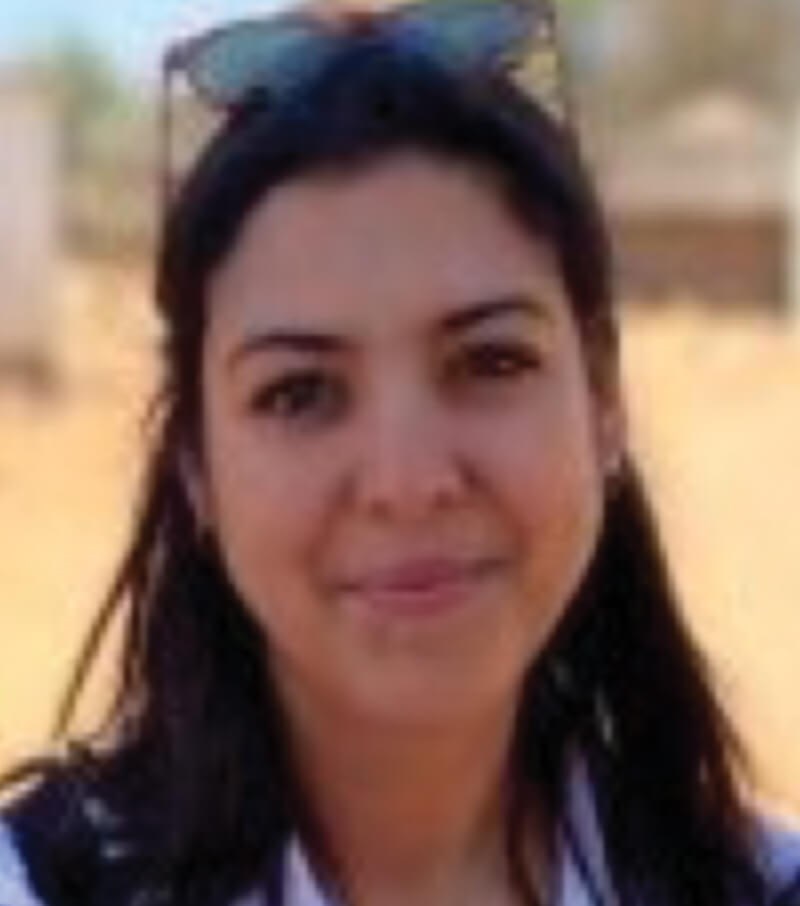
Third national survey in The Gambia – Islay Mactaggart
The third survey in The Gambia was carried out in 2019, providing information on the further evolution of the NEHP. ICEH’s Professor Matthew Burton and I supported the Gambian NEHP Coordinator to complete the third national eye health survey, drawing in additional support from ICEH and other eye health stakeholders.
The 2019 survey was led by Abba Hydara, a Gambian ophthalmologist, who was fundamental in the evolution of the NEHP and is strongly committed to the eye health needs of the population. The maturing of the programme enabled an increase in the number and type of questions asked to determine where are we now?
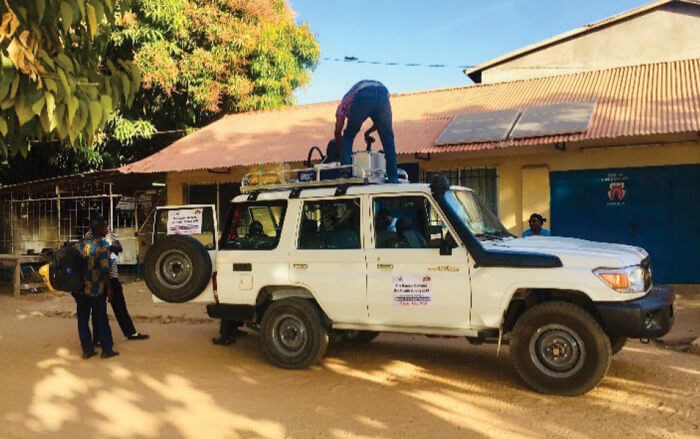
Loading a vehicle for fieldwork during the 2019 survey.
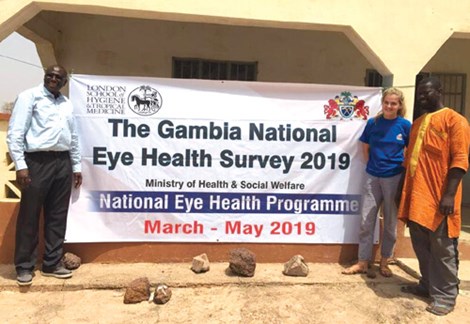
Participants in the 2019 survey, including its leader, Abba Hydara, on the left.
The 2019 survey examined over 9000 participants nationally, requiring six months of data collection by four teams, each comprising an ophthalmologist, optometrist or optometry technician, ophthalmic medical assistant, general nurse, mental health nurse and two enumerators. Survey teams carried equipment including slit-lamps and desktop posterior segment cameras with them, setting up a central examination area in each sampled community.
The sample size and informed consent process for participants were set up to allow for a five-year follow-up study, which will allow us to establish a cohort from the 2019 sample and document progression of eye disease over time. We are currently seeking funding for this follow-up, anticipated for 2024.
"The LINK has changed the face of ophthalmology in The Gambia. This has been a major morale booster in terms of service delivery. It is a unique experience that gives the staff confidence and insight"
Dr Winston Ceesay, CEO and Consultant Ophthalmologist, SZRECC.
The survey results showed a further reduction in blindness since the 1996 survey. However, moderate and severe vision impairment had increased [11]. The NEHP is adapting its programme to meet the new challenges highlighted in the survey.
Summary
These national surveys showed not only the magnitude and causes of blindness in The Gambia but also provided the evidence on which to base a national programme to address the causes of blindness. Repeat surveys show that the implementation of a programme to address the identified causes does successfully reduce blindness. The knowledge gained in The Gambia was critical in providing the evidence needed for global programme development and delivery to address blindness [8] and specifically trachoma [7]. This emphasises the critical role that good-quality evidence plays in eye health programme planning.
References
1. Chirambo MC, Tielsch JM, West KP, et al. Blindness and visual impairment in southern Malawi. Bull World Health Organ 1986;64(4):567-72.
2. Sukwa TY, Mwandu DH, Ngalande TC, et al. Prevalence of blindness and visual impairment in the Luapula Valley, Zambia. Trop Geogr Med 1988;40(3):237-40.
3. IAPB: The International Agency for the Prevention of Blindness.
www.iapb.org
4. ICEH: International Centre for Eye Health.
https://iceh.lshtm.ac.uk
5. Faal H, Minassian D, Sowa S, Foster A. National survey of blindness and low vision in The Gambia: results. Br J Ophthalmol 1989;73(2):82-7.
6. Faal H, Minassian DC, Dolin PJ, et al. Evaluation of a national eye care programme: review after 10 years. Br J Ophthalmol 2000;84:948-51.
7. World Health Organization. WHO Alliance for the Global Elimination of Trachoma by 2020.
www.who.int/initiatives/who-alliance-
for-the-global-elimination-of-trachoma-by-2020
8. VISION 2020.
www.iapb.org/about/history/vision-2020/
9. Kanyi S, Hydara A, Sillah A, et al. The Gambia Trachomatous Trichiasis Surveys: Results from Five Evaluation Units Confirm Attainment of Trachoma Elimination Thresholds. Ophthalmic Epidemiol 2023;1-9. [ePub ahead of print]
10. Aboe, A, Joof BM, Kanyi SK, et al. The Gambia has eliminated trachoma as a public health problem: Challenges and successes. PLoS Negl Trop Dis 2022;16(3):e0010282.
11. Hydara A, Mactaggart I, Bell SJ, et al. Prevalence of blindness and distance vision impairment in the Gambia across three decades of eye health programming. Br J Ophthalmol 2021;107(6):876-82.
12. Martin S, Ceesay W, Sohna H, Zondervan M.
The Gambia-Swansea VISION 2020 LINK: building eye care services and international friendships. Eye News 2014;21(1):26-8.
[All links last accessed June 2023]
COMMENTS ARE WELCOME

